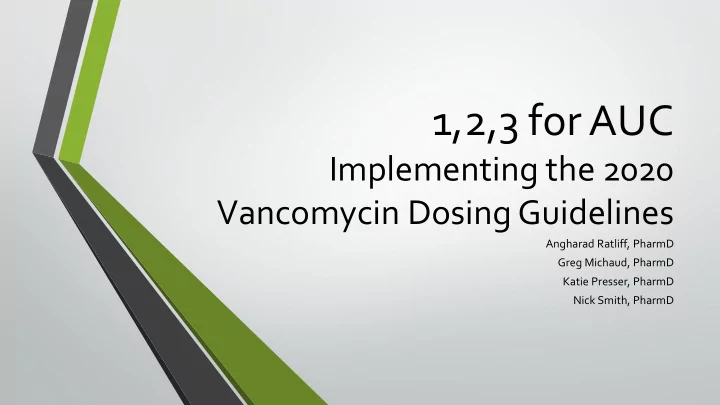

1,2,3 for AUC Implementing the 2020 Vancomycin Dosing Guidelines Angharad Ratliff, PharmD Greg Michaud, PharmD Katie Presser, PharmD Nick Smith, PharmD
Objectives • Discuss the rationale for implementing AUC dosing with vancomycin • Identify successful practices for transitioning from trough-based to AUC- based vancomycin dosing protocols • Discuss common barriers and identify potential solutions for implementation
Overview • Background – Why AUC dosing? • How do I do this? Calculation tools • When do I do this? Indications, MRSA vs non-MRSA infections, Special Populations, OPAT • Who else is involved? • Lab • Nursing • Pharmacy education
Introducing the Panelists • Angharad – Alaska Regional Hospital • Greg – MatSu Regional Medical Center • Katie – Alaska Native Medical Center • Nick – Providence Alaska Medical Center
Background: Why AUC? 2009 Guidelines 2020 Guidelines • • AUC/MIC 400-600 AUC/MIC ≥ 400 • • AUC/MIC < 400 – encourages emergence of resistance Trough of 15-20 mg/L as a surrogate • • Assume MIC of 1 Actual body weight for determining dosage • • Vancomycin-associated AKI – Loading doses for severe infections • Increased with AUC > 650 • Knowledge Gaps: • Vancomycin monitoring • Pediatrics • Patients at high risk for nephrotoxicity • Morbidly obese patients • Patients with unstable renal function • Renal failure • Patients receiving prolonged courses of therapy ( > 3-5 • days) Prolonged or continuous infusion • • Frequent or daily monitoring for unstable patients Safety data for dosages > 3 g/day • • Weekly monitoring for stable patients Safety and efficacy of targeted troughs 15-20mg/L
Methods of Calculating AUC • Bayesian calculators • Well- developed vancomycin population PK model + individual patient’s observed drug concentration • Does not require steady state conditions • Allows for trough-only sampling in select populations • Limited information in special populations – obese, critically ill, pediatric, patients with unstable renal function • First order PK analytic equations • 2 steady state serum concentrations • Lacks adaptive ability of Bayesian calculations
AUC Calculators • Prov Excel calculator • Precise PK • Vancopk.com • InsightRx • Integration into EMR • Turner, et al. Pharmacotherapy 2018 • Review of APK, BestDose, DoseMe, InsightRx, PrecisePK • Considerations: integration into EMR, $$$, training required, adaptability
AUC Dosing Based Upon Indication? • Guidelines – serious MRSA infections only • Serious infections = bacteremia, sepsis, infective endocarditis, pneumonia, osteomyelitis, meningitis • Easier implementation across the board? • Increased workload on nursing/lab/pharmacy • Methods to decrease workload? • Which indications? • Differentiating MRSA from non-MRSA infections
Special Patient Populations • Obesity • Increased risk of vancomycin-induced nephrotoxicity • Vd increase not reliably associated with weight increase • Loading dose (20-25mg/kg) recommended in patients with serious infections • 3gm dose cap • Max daily vancomycin doses of 4.5 gm/day • 2 level analysis
Special Patient Populations • Renal Failure • Intermittent HD: pre-dialysis HD levels between 15-20mg/L achieves AUC 400-600 • Loading doses based upon actual body weight and if dose is to be administered intradialytically or post-dialysis • Benefits of administering dose in dialysis vs. after dialysis • Continuous renal replacement therapy (CRRT) • Loading dose of 20-25 mg/kg actual body weight • Initial maintenance dose: 7.5 – 10mg/kg q12h • Serum concentration monitoring with 2 levels within 24 hours • Dose based upon levels?
Long-term Therapy/Transition to Outpatient • Surrogate trough monitoring • When to use trough-only? • Continuous infusion?
Nursing Considerations • Nurses can be your make or break for AUC dosing • Explaining the “WHY” is essential • Plans for nursing education • Concerns from nursing
Pharmacist Education • Gaps in education • Competency assessments • On-hire • On-going • One-on-one meetings vs. group training sessions
Lab Considerations • Labeling concerns: • Education on moving from single level to 2 level analysis • Terminology for lab orders: peak/trough, 2 randoms, AUC 1/AUC2 • Make sure you are looking at critical levels • MIC concerns: • CLSI allows for variability +/- 1 dilution • E test method consistently higher MICs • True rates of MIC of 2 much lower than previously reported
Open Forum This Photo by Unknown Author is licensed under CC BY-NC
Recommend
More recommend